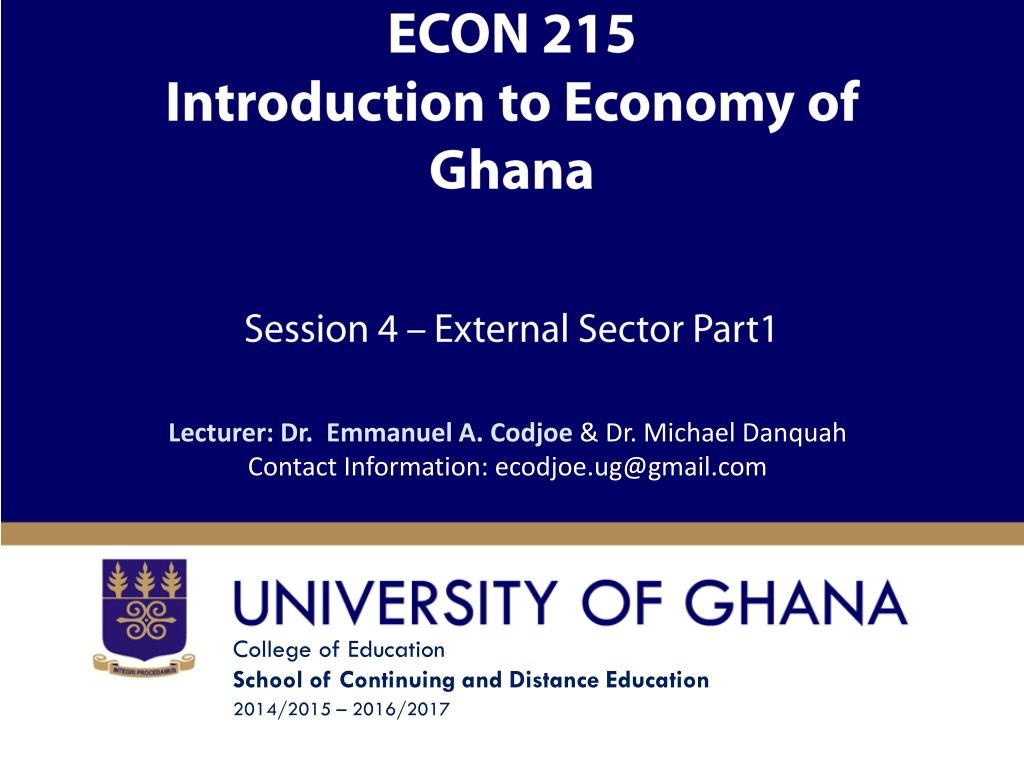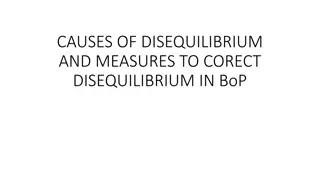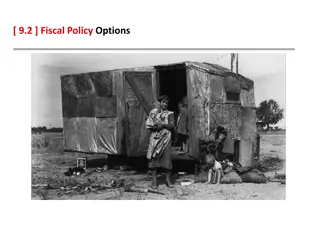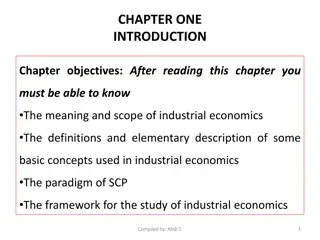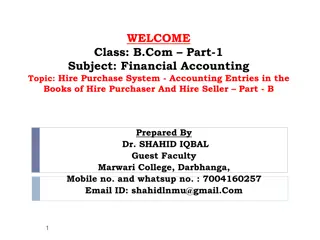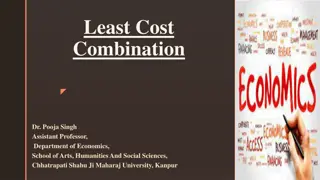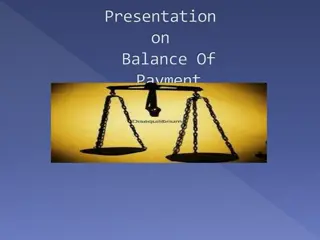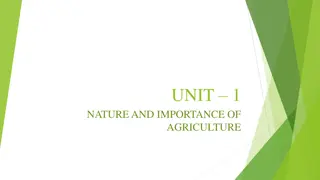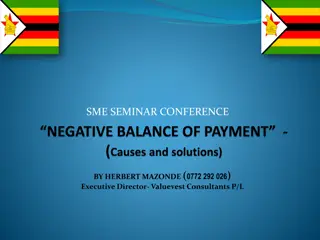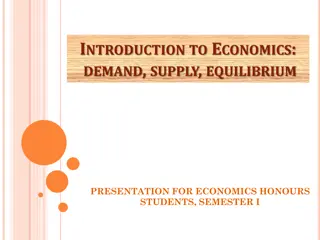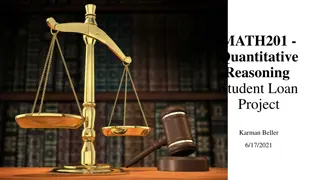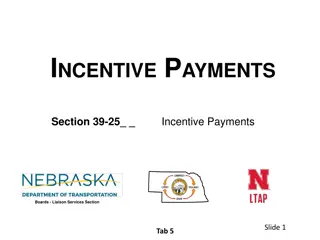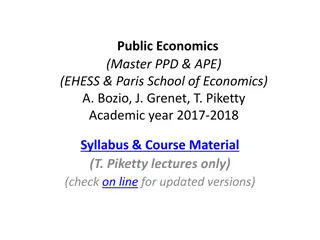Balance of Payments in Economics
The balance of payments (BoP) is essential in understanding a country's economic transactions with the rest of the world. Learn about its components, debit and credit items, and national income accounting in an open economy.
Download Presentation

Please find below an Image/Link to download the presentation.
The content on the website is provided AS IS for your information and personal use only. It may not be sold, licensed, or shared on other websites without obtaining consent from the author.If you encounter any issues during the download, it is possible that the publisher has removed the file from their server.
You are allowed to download the files provided on this website for personal or commercial use, subject to the condition that they are used lawfully. All files are the property of their respective owners.
The content on the website is provided AS IS for your information and personal use only. It may not be sold, licensed, or shared on other websites without obtaining consent from the author.
E N D
Presentation Transcript
Lecturer: Dr. Emmanuel A. Codjoe & Dr. Michael Danquah Contact Information: ecodjoe.ug@gmail.com College of Education School of Continuing and Distance Education 2014/2015 2016/2017
Session Overview Session Overview: A country which does not trade with another country stands the risk of not increasing its economic welfare. This implies that the external sector of (every) country is very important. This session seeks to introduce the students to the external sector in Ghana. Goals/ Objectives: At the end of the session, the student will Explain what the balance of Payments (BoP) is Know the components of BoP Identify which items are debit items and which are credit items Analyze national income accounting in an open economy Slide 2
Session Outline The key topics to be covered in the session are as follows: Topic One: Introduction to External sector Topic Two: The Balance Of Payments Account Topic Three: National income accounting in an open economy Slide 3
Reading List Refer students to relevant text/chapter or reading materials you will make available on Sakai Slide 4
Topic One INTRODUCTION TO EXTERNAL SECTOR Slide 5
What is Balance of Payments (BoP)? The Balance of Payments (BoP) is a presentation of all the economic transactions between a country s residents and the rest of the world. The term resident does not coincide with the original meaning of the word. An individual who is present in Ghana is not necessarily a resident of Ghana for the purposes of calculating the BoP. Residents are people who are permanently resident in a country. That they go outside the country for one reason or another does not change their status. Thus tourists, diplomats, and military personnel serving as peacekeepers are all regarded as residents of the country from which they came. The presentation can involve transactions over a specified interval of time, usually a month, a quarter or a year. During the specified period there are millions of transactions of individual households, firms, and governments. These are summed up to calculate for the Balance of Payments. Slide 6
Why is Debit and Credit? Movement of a good, service or financial asset is considered to be a debit or credit. Debit is any transaction that gives rise to payments to the rest of the world and gifts made to non-residents. Thus, debit includes: i. Goods and services acquired from non-residents, for example when a trader in Ghana imports Nokia phones from Finland. An example of a service is when Ghana Commercial Bank employs a foreign consultant to set up its database ii. Gifts and transfers made to non-residents an example is when the government of Mozambique. iii. Assets acquired from residents; also known as capital outflow. An example is when Anglo-Gold Ashanti acquires a gold mining company in Tanzania. Debit is entered with a negative sign Slide 7
Why is Debit and Credit? Contd Credit is any transaction that gives rise to receipts from the rest of the world and gifts received from the outside world. It is given by the following activities: i. Goods and services provided to non-residents-an example is when Ghana Cocoa Board exports cocoa to the UK. ii. Gifts or transfers received from non-residents- example when you receive some money from your brother in the US. iii. Assets given up to non-residents; also called capital inflow- an example is when an American acquires shares in Credit is entered with a positive sign. Slide 8
Double Entry Bookkeeping The concept of double bookkeeping used by accountants is also used to compile the BoP. Under this concept every complete transaction will result in two entries that have exactly equal values but opposite signs as a debit with a negative and as a credit with a positive sign. This is because every transaction entails the movement of a good, service or asset which must be paid for. The payment or agreement as to how payment will be made constitute a second movement which must also be recorded. Sometimes payment is not made immediately but agreement is reached as to how payment is to be made. The result of this principle is that the total value of debit entries must equal the total value of credit entries. Thus the balance of payments which represents the difference between total debits and total credits must sum up to zero. In order words, BoP must necessarily balance. Slide 9
Examples of Double Entry Bookkeeping Ghana Cocoa Board exports 5 million dollars worth of cocoa to the US. A cheque is issued by the importer in US drawn on a bank in New York. In Ghana s BoP the movement of cocoa is entered as a credit with a plus sign. The cheque payment is an acquisition of a foreign account by the Ghana Cocoa Board. It is thus entered as a debit of 5 million with a minus sign. Korle-Bu Hospital imports generators worth one million euros from Germany. Payment is made by the transfer of foreign exchange by Korle-Bu which the hospital buys from the Bank of Ghana. In this case a debit is recorded on Ghana s BoP since the payment constitutes the acquisition of a Ghanaian asset by non-residents. Slide 10
Topic Two THE BALANCE OF PAYMENTS ACCOUNT Slide 11
Presentation of the Balance of Payments While presentation by different nations may differ slightly there is a standard format that they all follow: the two basic divisions of the Balance of Payments are the current account and the capital account Current Account consists of: i. All transaction involving goods and services in which the transferee gives an economic value in return ii. Gifts and transfers Capital Account also known as the financial account shows changes in the country s foreign financial assets and liabilities. This includes changes in the country s international reserves. Slide 12
Current Account 1. a. Goods and Services Merchandise also known as visible consists of items that we can drop on our feet . Basically they are tangible goods such as computers, cars, cocoa, timber, etc. When Ghana exports cocoa, this item is credited and when she imports computers it is debited. Factor Services These are payments made for the use of foreign assets that have come into a country earlier. Profits earned by foreign companies in Ghana (entered as debit) or by a Ghanaian company abroad (entered as credit) Dividends, i.e., earnings on shares of foreigners in Ghana (debit) or by Ghanaian owned shares abroad (credit) Interest, i.e., payment by a Ghanaian company on a loan contracted earlier (debit) or earned by a Ghanaian entity that lends abroad (credit) b. Slide 13
Current Account Contd c. Non-Factor Services these are earnings by foreign companies on services rendered to residents or vice versa. Examples include: Freight when a Ghanaian company uses a foreign shipping line (entered as debit) Insurance when a Ghanaian uses the services of a foreign insurance company (entered as debit) Unilateral Transfers also called unrequited receipts are movements of goods and services for which no payment is made. Thus, for instance, if Ghana receives a gift of milk powder from American government this will be entered on the merchandise portion as a debit (import) and on the unilateral portion as credit. A gift from Ghana to Mozambique will be entered on the merchandise portion as a credit (export) and on the unilateral line as a debit. Private Remittances and Gifts consists of gifts by individuals such as those from your brother in the US. Gifts by private entities such as NGOs are also entered here. Government Transfers are gifts at governmental levels such as from government of foreign countries and international organizations. 2. a. b. Slide 14
Capital Account 1. Private Capital this involves the selling and buying of assets by private sector participants. Direct Investment This is the act of purchasing enough shares in a company to at least have an effective voice in its management. It also includes outright purchase of a company. By international convention, at least 30% ownership of a company is regarded as direct investment. Portfolio Investment (Securities and Banking Flows) This is the act of purchasing an asset that does not give the purchaser control. The distinction between long-term and short-term is based on the original maturity of the asset. If it is more than one year it is long term, less than one year short term. Thus a security that is issued to mature in 18 months is a long term investment. Assets with no stated maturity such as a share in a company are considered to be long term. Bank balances however are considered to be short term. Generally, long term investments are regarded as being sensitive to market sentiments whilst short term is regarded as something that can move in quickly and move out just as quickly. a. b. Slide 15
Capital Account Contd 2. Official Reserves Transactions these are assets available for use by the central bank authorities of a country in meeting BoP needs. They are kept in the form of: Monetary Gold this was very important during the fixed exchange rate era. At that time, countries were expected to fix their currency to 1 oz. of gold. In this floating exchange rate era gold has lost its importance as a reserve asset. IMF credits and SDRs the IMF is responsible for managing the international financial system. In this capacity it lends to countries that have BoP problems. The loans obtained are entered as reserves. SDRs are a special kind of reserve initially issued on the basis of their size. Countries can thus keep reserves in SDRs. Foreign Exchange Reserves for most countries these consists of assets kept in the form of dollars, euros, and other important currencies. This is the popular form of keeping reserves. a. b. c. Slide 16
The Concept of Deficit and Surplus Balance of trade: it relates simply to the merchandise balance. For a typical developing country such as Ghana, this balance can be negative or positive. However, most natural resource rich countries like an oil producer this is likely to be positive. Balance on Services: This is the balance of factor and non-factor services. A typical developing country like Ghana has not got a well developed non-factor services sector such as banking, insurance and software services. Thus Ghana tends to import more of these services than exports. Also, since Ghana does not send much capital outside it does not earn much from it. Therefore, this balance will tend to be negative for a developing country like Ghana. Balance on current account: it is the combination of the balance on goods and services, and that of unilateral transfers. Slide 17
The Concept of Deficit and Surplus Cont d Balance on Capital account: this is the balance on private capital Basic Balance: it is the sum of the current account balance and the balance on capital account excluding short term capital. The essence of the exclusion is to remove items that are considered volatile from the balance. This balance is then meant to capture the workings of the fundamental economic forces. Overall Balance: this term is used when short term capital is added to the basic balance. Slide 18
Topic Three NATIONAL INCOME ACCOUNTING IN AN OPEN ECONOMY Slide 19
Some Useful Identities In a closed economy, the national income can be calculated by summing the comsumption expenditures by consumers, investment expenditures by businesses and governent expenditures. So this gives us: 1. Y C + I + G This indicates that the national income/output(Y) is consumed (C), invested (I),or purchased by the government (G). However in an open economy i.e., an economy trading with the rest of the world, we need to add exports to the right hand to account for output sent abroad. Also, we need to account for only what is produced in the country by subtract(subtracting) imports from the right hand side. Performing the above operations gives us: 2. Y= C + I + G + X M Where X is exportsand M is imports. Slide 20
Useful Identities: Relationship between Current Account and Income-Expenditure C + I + G can be classified as domestic expenditure, E Thus we can write: 3. Y = E + X M (X M) can be regarded as the current account balance since national income only measures currently produced goods and services. Thus we can replace (X M) with B for balance. Thus, 4. Y = E + B Making B the subject gives us 5. B = Y E Equation 5 reveals a lot. It says that the balance on current account is the difference between output and expenditure (output gap). So for instance if B is negative that implies (Y E) is negative. A current account where B is negative implies that expenditure must be greater than output. Slide 21
Useful Identities: Relationship between Current Account and Income-Expenditure Cont d Now when a country is running a current account deficit, it must be running a capital surplus. A capital account surplus implies capital inflows from non-residents. Now sometimes a country may be running a deficit but may find it difficult to attract the capital from abroad. One form of capital inflow though is loans from abroad. A country with this kind of predicament is then forced to get to the IMF for the loans. The IMF might agree to lend but then impose some conditionality i. e that a country must fulfill. The options open to a country from equation 5 is either to increase output and/or reduce expenditure. Thus it should not come as a surprise when as part of the IMF conditionality, countries are told to cut expenditure. Normally raising output is more difficult and takes time. But measures are usually put in place to ensure that those in the productive sector have the incentive to raise output. Slide 22
Useful Identities: Current Account and The Budget There is another way of looking at national income accounting: Starting from equation 2 2. Y = C + I + G + X M Subtract C from both sides 6. Y C = I + G + X M Subtract tax revenue T from both sides 7. Y C = I + (G T) + (X M) Now the term on the left hand side is Income from which we subtract consumption and taxes. At the individual level we can easily that this is saving. Thus in this aggregate framework this is national saving. We can thus write: 8. S = I + (G T) + (X M) Where S is saving given by (Y C T). Slide 23
Useful Identities: Current Account and The Budget Cont d Subtract I from both sides 9. We can re-arrange and get 10. X M = (S I) + (T G) or 10b. B = (S I) + (T G) Let s assume that S = I, this implies 11. B= T G S I =(G T) + (X M) If B is negative (current account deficit) that implies G is greater than T. That is government expenditure is greater than tax revenue or what we call a budget deficit. This reinforces the earlier result that one solution to a deficit problem is a cut in expenditure. Slide 24
Useful Identities:The Current Account and Investment/Saving Getting back to equation 10b we assume that T=G. This then leaves us with 12. B = S I This implies that with a deficit, investment is greater than saving i.e saving in the country is inadequate to finance its investment. Equation 12 shows that if there is a deficit it means internal saving is inadequate to finance needed investment. Thus, there is need for capital inflow to finance the investment. One option for a country then is to raise its saving. This is the other side of the coin to reducing expenditure. Slide 25
Policy Implications There are some policy implications here: If for one reason or the other Ghana is not able to save adequately to finance her investment then she needs to attract foreign saving in the form of capital inflows. Thus the right conditions must be created to attract this capital These infrastructure and a well functioning regulatory and legal framework include macro stability, well functioning Slide 26
References Slide 27
